By rjs, a rural swamp denizen from Northeast Ohio, and a long-time commenter at Naked Capitalism. Originally published at MarketWatch 666.
Today we look at two major reports on active home mortgages; one, from the Mortgage Bankers Association, shows both mortgage delinquencies and foreclosures down in the 2nd quarter; the other, from LPS (Lender Processing Services) shows a sudden 18.3% spike in new mortgage delinquencies in June, the most newly delinquent homeowners in a month at least 2 years…We’ll unravel what both reports reveal…Then we look at the new trade report for June, which showed that our trade deficit was down over 22%, that exports hit an all time record, and that results might revise 2nd quarter growth to a respectable 2.5%… What is this, an Obama wet dream coming early, with export jobs for everyone? Hardly. We find big chunks of that June trade change can be accounted for by big jumps in jewelry, gem diamonds, monetary gold & refinery exports, and reductions in imports of much of the same…Something’s going on there, but it ain’t about jobs…
The MBA & LPS on Delinquent Mortgages & Foreclosure Inventories at Mid-Year
This week saw the release of both of the major national reports that track the condition of US home mortgages, coincidentally as of the last day of June, giving us an opportunity to compare them side by side, which should give us a better picture of the overall situation. We should note they’re not directly comparable, however, because the Mortgage Bankers Association’s (MBA) 2nd quarter National Delinquency Survey is issued quarterly and is seasonally adjusted, whereas the June Mortgage Monitor (pdf) from Lender Processing Services (LPS) is a report issued monthly that is not seasonally adjusted. On previous occasions where their release has coincided, we’ve noted that the MBA has tended to show slightly higher delinquency rates than LPS; that’s also true this time, though it’s interesting to note that this end quarter they’re converging, as the MBA report has mortgage delinquencies down slightly, whereas LPS shows a substantial jump in late house payments in June, turning their 3 month delinquency figures negative. The MBA also notes that the improvement they show in seriously delinquent mortgage percentages may be slightly less than they indicate because "at least one large specialty servicer that has received a number of loan transfers did not participate in the MBA survey"
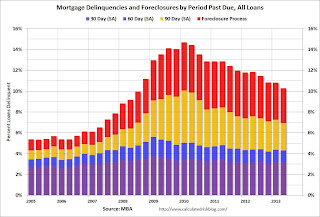 According to the MBA, the national delinquency rate, or the percentage of homeowners who were late at least one house payment late but not in foreclosure, declined to a seasonally adjusted 6.96% of all loans outstanding at the end of the second quarter of 2013, down from 7.25% at the end of the first quarter, and down from a delinquency rate of 7.58% a year ago, and the lowest level since mid-2008.. The percentage of mortgages that were in the foreclosure process, or those who’ve had foreclosure proceedings initiated against them but have not yet had their home seized, also fell over the quarter to 3.33% of all mortgages, from 3.55% at the end of the first quarter, and down from the foreclosure inventory rate of 4.27% one year ago. New foreclosures were started on just 0.64% of mortgages in the 2nd quarter, down from 0.70% in the first quarter and from 1.42% of all properties at the September 2009 foreclosure peak. The seasonally adjusted "serious delinquency rate", which includes those who more than 90 days delinquent in addition to those in the foreclosure process, was at 5.88% at the end of the quarter, down from 6.39% at the the end of the first quarter and a decrease from the 7.31% serious delinquency rate of a year ago.. Combined with those who have missed at least one mortgage payment, the total of all delinquent or in foreclosure mortgages at the end of march amounted to 10.29% of all mortgages on an seasonally adjusted bases, and 10.13% on an unadjusted basis, so despite the continual improvement in the overall delinquency rate, there were still more than one in ten homeowners who were behind on housepayments at the end of June…
According to the MBA, the national delinquency rate, or the percentage of homeowners who were late at least one house payment late but not in foreclosure, declined to a seasonally adjusted 6.96% of all loans outstanding at the end of the second quarter of 2013, down from 7.25% at the end of the first quarter, and down from a delinquency rate of 7.58% a year ago, and the lowest level since mid-2008.. The percentage of mortgages that were in the foreclosure process, or those who’ve had foreclosure proceedings initiated against them but have not yet had their home seized, also fell over the quarter to 3.33% of all mortgages, from 3.55% at the end of the first quarter, and down from the foreclosure inventory rate of 4.27% one year ago. New foreclosures were started on just 0.64% of mortgages in the 2nd quarter, down from 0.70% in the first quarter and from 1.42% of all properties at the September 2009 foreclosure peak. The seasonally adjusted "serious delinquency rate", which includes those who more than 90 days delinquent in addition to those in the foreclosure process, was at 5.88% at the end of the quarter, down from 6.39% at the the end of the first quarter and a decrease from the 7.31% serious delinquency rate of a year ago.. Combined with those who have missed at least one mortgage payment, the total of all delinquent or in foreclosure mortgages at the end of march amounted to 10.29% of all mortgages on an seasonally adjusted bases, and 10.13% on an unadjusted basis, so despite the continual improvement in the overall delinquency rate, there were still more than one in ten homeowners who were behind on housepayments at the end of June…
The above bar graph from Bill McBride at Calculated Risk gives us a picture of what the relative size of each of the so-called delinquency “buckets” from the MBA survey have looked like over time. Each bar represents the percentage of homes delinquent or in foreclosure at the end of each quarter since the beginning of 2005, with the percentage more than 30 but less than 60 days behind on their housepayments color coded purple, the percentage more than 60 but less than 90 days delinquent in blue, the percentage that are seriously delinquent, ie, more than 90 days behind but not yet in foreclosure in yellow, and the percentage of those that are in the foreclosure process in red.. It’s clear that the total of all delinquent or in foreclosure homeowners is down considerably from the record 14.69% of all mortgages that the MBA survey showed in the first quarter of 2010, but still well above the 5.5% to 5.7% range of troubled mortgages common before the crisis..
The next graph, from the MBA, shows the percentage of mortgages in the foreclosure process by state, with the states that have a judicial foreclosure process, where the bank must prove their right to foreclose on a homeowner in court, coded in dark navy, and those states with a non-judicial foreclosure process shown in red.. Obviously, the judicial process has slowed foreclosures down in those states that have it. The MBA gives the average foreclosure inventory in judicial states at 5.59% of all mortgages in those states, compared to a ratio of 1.86% of all mortgages for non-judicial states. Nevada, the only non-judicial state in the top dozen with the highest foreclosure inventories, passed a law in 2011 making it a felony if a mortgage servicer made fraudulent representations concerning a title, and imposed fines up to $5,000 for falsifying documents, which slowed foreclosures in that state to a near standstill. The states showing the largest foreclosure inventories are Florida at 10.58%, down from 11.43% in the first quarter, New Jersey at 8.01%, down from 9.00% in the last report, New York at 6.09%, down from 6.18%, and Maine at 5.62% down from 5.80%.. Meanwhile other states that have experienced significant foreclosures, such as California, with a foreclosure inventory rate of 1.64%, and Arizona at 1.51%, have a much smaller backlog because without the judicial process the banks can proceed on homeowners with impunity..
In contrast to the MBA survey, which showed delinquencies down to 6.96%, the June Mortgage Monitor (pdf) from Lender Processing Services (LPS) showed that new mortgage delinquencies spiked up 18.3% in June, after declining 5 months in row, raising their national mortgage delinquency rate to 6.68% from the mortgage crisis low of 6.08% in May.. Data from LPS showed that the nearly 10% jump in the national delinquency rate in June was largely the result of approximately 700,000 homeowners who were current on their mortgages in May falling behind by one payment in June. The deterioration in mortgages delinquencies was widespread, as the newly delinquent rate rose by more than 10% in all 50 states and did not seem to be the result of higher interest rates, as the delinquency rate for those with 30 year fixed rate mortgages increased at a slightly quicker pace than that for those with adjustable rate mortgages…
Of 49,823,992 active mortgages in June, LPS reported that 4,785,000 home loans, or 9.61% of all first lien mortgages, were at least one payment delinquent or in foreclosure at the end of June; of those, 1,983,000 homes loans were at least 30 days but less than 90 days late; another 1,344,818 mortgages were 90 or more days delinquent, but not yet in foreclosure, and 1,458,000 properties, were in the foreclosure process, ie, they had received at least one notice but their home had not yet been seized.. That foreclosure inventory was down from 1,335,000 in May, and at 2.93% of all mortgages, represents the first time homes in foreclosure fell below 3% of tracked properties since early 2009. There were 109, 042 foreclosure starts in June, the lowest monthly number of new foreclosures in a month since the crisis began..
As most of the mortgage monitor is a graphic presentation, we’ll have to look at some of those to see the rest of the story.. Our first graph is from page 4 of the mortgage monitor pdf and tracks with a green line the percentage of active home loans that have been in the foreclosure process, also known as the foreclosure inventory, from 1995 to the present. These are the home loans in between the time the servicer’s attorney first initiates the foreclosure and the "foreclosure sale", which typically transfers title to the bank (terminology is on page 25 and 26 of the pdf). At 2.93% of home mortgages outstanding, we can see that’s down considerably from the October 2011 peak of 4.29%, but still nearly six times the 0.44% foreclosure inventory of pre-crisis December 2005. Then in red, this graph tracks the percentage of loans that have been delinquent monthly over the same period, where we can see this June’s spike to 6.68% delinquent, following the largest year to date decline in delinquencies since 2002. We can also see the seasonality of delinquencies, where they usually peak at year end, when most people get overextended during the holidays, and then decline over the first few months of each year as homeowners catch up. Even at 6.68%, June’s delinquency rate is still below the 7.17% rate of December 2012, when many homeowners put holiday shopping ahead of their housepayments, and still well below the peak percentage of 10.57% registered in January 2010, although it remains roughly 50% over the pre-crisis level, marked on the chart at 4.27% in December 2005…
The map below, from page 5, shows the percentage of new delinquencies by state; ie, those who were current on their mortgage in May but fell behind in June. Unfortunately, the percentages even on the original map are difficult to read, but what the map shows is that all 50 states chalked up a new delinquency rate well over 10%, ranging from a low of 13.9% new mortgage delinquencies in Nevada to as high as 31.7% new delinquencies in Colorado and a 29.6% jump of those newly behind on their housepayments in Utah. The darker the pink, the greater the percentage of new 30 day delinquencies. Note that every state except Connecticut in the Northeast saw an increase of more than 20% in new mortgage delinquencies, as did Wisconsin, Illinois, Minnesota, North & South Dakota, Nebraska, Oklahoma, Idaho, New Jersey and South Carolina.
Next, the adjacent chart, from page 6 of the mortgage monitor, serves to show that the increase in delinquencies in June was not interest rate driven, because the increase in delinquencies for those with 30 year fixed rate mortgages, shown in blue, at 19% month over month, was greater than the 18% month over month increase for those with adjustable rate mortgages, shown in red. But also note on this chart that ARMs have been consistently more delinquent than the 30 year mortgages, and new delinquencies in ARMs at 3.65% in June outpaced new delinquencies in 30 day mortgages at 2.87%….
Then in our next graph below, from p 7 of the mortgage monitor, we’ll see that it was not just new delinquencies, but every delinquency bucket that increased in June. This graph tracks the month over month change in quantity of mortgages of each delinquency range from the beginning of 2008 to the present. In blue we see the number of mortgages in each month that were current in the previous month that fell behind in that month; as LPS pointed out, there were over 700,000 new delinquent mortgages in June, which you see in the spike at the end of the graph; we’ll note that the 30 day delinquency bucket increased from 1,243,194 in May to 1,471,134 in June, so that means over 450,000 other mortgagees who were 30 days late in May either caught up or fell further behind in June.. In red, we have the number of those mortgages that went from over 30 days in arrears to over 60 days late. The number of those between 60 and 90 days delinquent went from 465,129 in May to 511,731 in June. And in green in the chart below we have shown the homeowners who went from over 60 days delinquent to over 90 days behind each month; in June, those seriously delinquent mortgages increased to 1,344,818 from 1,334,660 in May. Finally, in purple below, we see the percentage that were seriously delinquent that had foreclosure proceedings initiated against them was down in June, and as we noted earlier, the 109,042 foreclosures initiated in June was the lowest monthly new foreclosures since before 2008…
The next graph, from page 8, shows that the deterioration in homeowner’s mortgage payment situations in June also affected the number of delinquent mortgages that "cured", or those who were delinquent who got caught up during each month. In red, we have graphed the number homeowners who were one to two months behind on payments who caught up on their payments each month, which collapsed to a five year low in June. Although LPS doesn’t provide the data, it also appears the same is true for those who were 3 to 5 months behind, as the violet line on that graph representing that cure bracket also seems to be at a 5 year low. Meanwhile, the number of those who were more than 6 months delinquent who got caught up in June, as indicated by the teal blue graph, also appears to be at it’s lowest level since early 2012. Note the number of cures for these last two is on the left scale, while it’s on the right for the short term delinquencies…
Despite this obvious deterioration in June mortgages, LPS Applied Analytics Senior Vice President Herb Blecher tried to spin it into a seasonal phenomena in the press release accompanying the release of the mortgage monitor, noting that payment situations deteriorated in June in all but 4 of the past 18 years. This may be true, but looking back over the record, we dont see a single month in the past two years that saw this large an increase in 30 day delinquencies; as we noted, the 30 day bucket saw an increase of 227,940 mortgages in June (from 1,243,194 to 1,471,134); last June’s increase was from 1,390,010 to 1,464,660, only one third that of this June’s at 74,960, and the delinquency rate increase in June 2011 was just 2.4%. Even the infamous September spike in mortgage delinquencies accompanying the release of the iphone 5 was smaller at 219,998 new delinquencies.. We did see June spending outpaced incomes by a bit last week, yet there is nothing else obvious in June data that we’ve seen to date that could have precipitated this apparent shortfall of homeowner budgets that would cause such a widespread and precipitous increase in new delinquencies.
We also want to take a look at some LPS graphics regarding the foreclosure inventory in judicial and non-judicial states, to compare to similar data we saw from the MBA. This next graph, to the right, from page 16 of the mortgage monitor, shows the foreclosure inventory as a percentage of all mortgages since the beginning of 2008.. You’ll recall these are those homes that are stuck in the foreclosure process but have not yet been seized.. The blue track on the graph shows the percentage of homes in judicial states that are in the foreclosure pipeline, now down to 4.91%, after having peaked at 6.60% in January of 2012. The red line tracks the percentage of home mortgages in non-judicial states that were in the foreclosure process; this is now down to 1.50%, after having peaked at 2.97% in December of 2010. The black line is simply the national average, now at 2.93%..
Meanwhile, the graph below, from page 15 of the mortgage monitor, shows the percentage of this foreclosure inventory that has proceeded to the next step each month, which is euphemistically referred to a a foreclosure sale, where the home is usually auctioned back to the bank in lieu of the unpaid mortgage debt and becomes part of their REO inventory (Real Estate Owned — terminology is on page 25 of the pdf).. As the red track representing non-judicial states shows, without court intervention this has historically proceeded quite rapidly, from home seizure rates above 12% of all foreclosure inventory early on in the crisis to the recent rate of 6.31% in June, which was up 15.16% from May’s rate.. The blue line shows the percentage of homes in judicial states that are in foreclosure which have been seized each month; you can see it dropped well below 2% when foreclosure fraud was in the news a few years back, but it’s now crept back up to over 3% at 3.02% of all foreclosed homes as of June, 6.74% more than May’s rate…
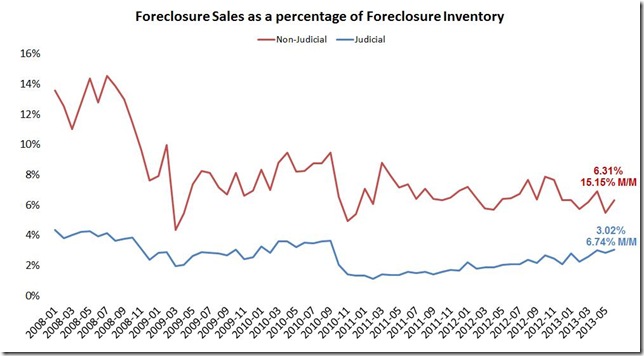
The next graph, from page 17 of the pdf, shows that the pipeline ratios, or the average number of months it typically takes for a foreclosure to be completed, have been converging for judicial and non-judicial states. In this computation, which you see on the chart, LPS takes the total number of seriously delinquent and the in foreclosure process mortgages and divides it by the average number of completed foreclosures per month in each state over the previous six months to come up with the number of months of foreclosure backlog there is for that state (assuming all seriously delinquent mortgages proceed to that final stage) With the slow pace of completed foreclosures nationwide, that pipeline has stretched out to well over 3 years nationwide; 54 months for judicial states and 39 months for non-judicial states. Note that the mean foreclosure pipeline time was as high as 118 months – nearly 10 years – for judicial states during the foreclosure moratoriums imposed by the banks during the wake of the robosigning scandal. The national average number of days that a foreclosed property has remained in the foreclosure inventory is now up to 860 days as of this report, while the average seriously delinquent mortgage has remained seriously delinquent for 512 days without proceeding to foreclosure…
Finally, the next two graphics will break this all down by state.. First, from page 22 of the pdf, we have the table of non-current mortgage and foreclosure percentages in all 50 states and the District of Columbia which we’ve featured in previous months. The first column shows the delinquency rate for each state, ie, the percentage of mortgages in each state that are at least one month behind and not yet in foreclosure, a category that’s jumped for each state this month.. The second column is the percentage in each state that are in foreclosure, which has been falling consistently, by at least a point or more every month over the past year, and the third column is the total non-current percentage, or sum of all those behind of their mortgage, which rose from 9.13% nationally in May to 9.61 in June. Note that the last column, which shows the year over year percentage change in non current mortgages in each state, is still falling for every state despite June’s jump, although some states, like New York, Vermont and Wyoming, have barely seen any change in a year…
Also note that judicial states, where banks must establish their right to foreclose in court, are marked on the table below by a red asterisk. These states have the highest percentages of mortgages still stranded in foreclosure, led by Florida, where LPS shows 9.5% of all mortgaged homes still in foreclosure, contrasted to the 10.6% in foreclosure the MBA showed. Other judicial states with a foreclosure inventory greater than 5% include New Jersey at 7.1%, New York at 5.8%, Hawaii at 5.7%, and Maine at 5.3%…non-judicial Mississippi has remained an outlier here years, with a low foreclosure rate despite the fact that 15.4% of their homeowners still remain non-current on their mortgages…
Lastly, the map graphic below, from page 18 of the pdf, shows the percentage improvement in "performance" of non-current mortgages that each state has made from worst of the mortgage crisis for each state.. Note that the scale runs from just 4.9% off the peak for the deep red state of New York, to a 65.7% "improvement" in dark green Arizona, where most seriously delinquent homeowners were quickly foreclosed on. You’ll note that the non-current inventory remains near the delinquency peak in most of the Northeast, with only 5% more mortgages in Maine current now than at the worst of the crisis, and just an 8.7% improvement from the worst in New Jersey…
June’s Trade Deficit
The key monthly economic release of the past week was on our International Trade in Goods and Services for June from the Dept of Commerce, which showed our June trade deficit was much smaller than expected and the lowest since October 2009. However, unlike the low deficits of 2009, which were brought on by recession reduced imports and the collapse of global trade overall, this month’s low deficit largely resulted from the highest exports on record, leading to widespread expectations there’d be a positive correction on the order of 0.8% to 2nd quarter GDP to 2.5%. As we noted last week, net exports for the second quarter were reported as a -0.81 drag on GDP…
Seasonally adjusted exports of $191.2 billion, $4.1 billion or 2.2% above those of May, and imports at $225.4 billion, $5.8 billion, or 2.5% less than May’s, resulted in a goods and services deficit of $34.2 billion, down 22.4% from the May deficit of $44.1 billion, which was originally reported at $45.0 billion. Our adjusted deficit in goods decreased by $9.7 billion to $53.2 billion as exports of goods increased $4.0 billion to $134.3 billion and our imports of goods decreased $5.7 billion to $187.4 billion, while our trade surplus in services increased by $0.1 billion to $18.9 billion as our exports of services increased $0.1 billion to $56.9 billion and imports of services were statistically unchanged at $38.0 billion.. On the same balance of trade basis, our unadjusted trade deficit in goods was at $50.6 billion, so the effect of the seasonal adjustment was to raise the aggregate goods deficit by $2.6 billion.
Our FRED bar graph below shows the monthly change in millions of dollars in our total exports, imports, and trade balance for every month going back to January 2008 (click for larger version). In each set of three bars, blue is the change in exports for the month, red is the change in imports, and brown is the change in the trade balance, with increases above the 0 line and decreases below it. That exports add to the change in the trade balance and imports subtract from it should be evident, as each brown bar is composed from the net change of the blue minus the net change of the red.
Commerce department reporting on exports and imports of goods are lumped into the very general end use categories of foods, feeds, and beverages, industrial supplies and materials, capital goods, automotive vehicles, parts, and engines, consumer goods, and "other" goods, which are then rounded to the nearest tenths of billions to reflect the imprecision of these monthly estimates. However, we can extract raw data for the larger components of those categories in millions from the full release with tables to give us a more precise clue as to what has been moving our trade balance (reference exhibit 7 for seasonally adjusted exports; exhibit 8 for imports)
The June increase in exports of goods included a $1.5 billion increase in exports of industrial supplies and materials to $43.3 billion, which included increases of $898 million in exports of fuel oil to $5,982 million, $575 million of other petroleum products to $4,694 million, $378 million more exports of organic chemicals to $3,070 million and $322 million more in monetary gold at $2,938 million. Exports of capital goods also increased by $1.5 billion, to 46.2 billion, which included a increase of $428 million in civilian aircraft engines to $2,659 million, an increase of $322 million in telecommunications equipment to $3,483 million, and an increase of $305 million in industrial engines to $2,626 million.. Exports of consumer goods also increased by $1.0 billion to $16.6 billion, including an increase of $673 million in jewelry to $1,494 million and an increase of $376 million in gem diamonds to $2,009 million, while exports of pharmaceuticals shrunk $317 million to $3,992 million…exports of foods feeds and beverages increased by $0.3 billion to $10.1 billion, led by a $160 million increase in wheat exports to $934 million and a $144 million increase in exports of meat and poultry to $1,640 million. Meanwhile, exports of other goods increased $330 million to $5,368 million and exports of automotive vehicles, parts, and engines decreased by a seasonally adjusted $439 million to $12,621 million..
The decrease in imports from May to June included our imports of industrial supplies and materials declining $2.5 billion to $54.6 billion, including $1,028 million less imports of fuel oil, $1,025 million less imports of other petroleum products, and $339 million less imports of non monetary gold, which were down to $3,070 million, $3597 million, and $1026 million respectively. Imports of crude oil, still our largest single item, were up $33 million to $21.993 billion, as oil averaged $96.93 a barrel in June, up a bit from $96.84 in May.. We also imported a seasonally adjusted $43.7 billion of consumer goods in June, $1.6 billion less than in May, as our imports of cellphones and similar goods fell $1,485 million to $7,705 million, our imports of gem diamonds fell $546 million to $1,734 million while our imports of TVs and video equipment rose $214 million to $2,514 million. Our June imports of foods, feeds, and beverages fell $0.4 billion to $9.5 billion as we imported $106 million less fruits and juices and $95 million less in cocoa beans with widespread declines in imports of other foodstuffs. In addition, imports of automotive vehicles, parts, and engines were up $0.3 billion to $25.7 billion and imports of other goods were up $1.2 billion, while imports of capital goods were statistically unchanged at $45.6 billion as increases of $300 million in imports of civilian aircraft engines and $116 million of materials handling equipment offset decreases of $176 million in imports of semiconductors, $140 million in computers and $111 million in computer accessories..
Our bilateral deficits in goods trade, which are not seasonally adjusted, generally improved across the board. Our goods deficit with China, which improved from $27.9 billion in May to $26.6 billion in June, still accounted for more than half of our $50.6 billion unadjusted goods deficit. Other major bilateral trade deficits on an unadjusted basis in June include a $7.1 billion deficit with the European Union, down from $10.8 billion in May, a $5.8 billion deficit with OPEC, $5.5 billion with Japan, $4.9 billion with Germany, $4.8 billion with Mexico, $3.0 billion with Saudi Arabia, $1.6 billion with South Korea, $1.6 billion with Canada, $1.4 billion with Ireland, $1.2 billion with Venezuela and $1.0 billion with India. Small bilateral trade surpluses were recorded with Hong Kong at $3.4 billion, Australia at $1.7 billion, Brazil at $1.6 billion and Singapore at $1.2 billion….
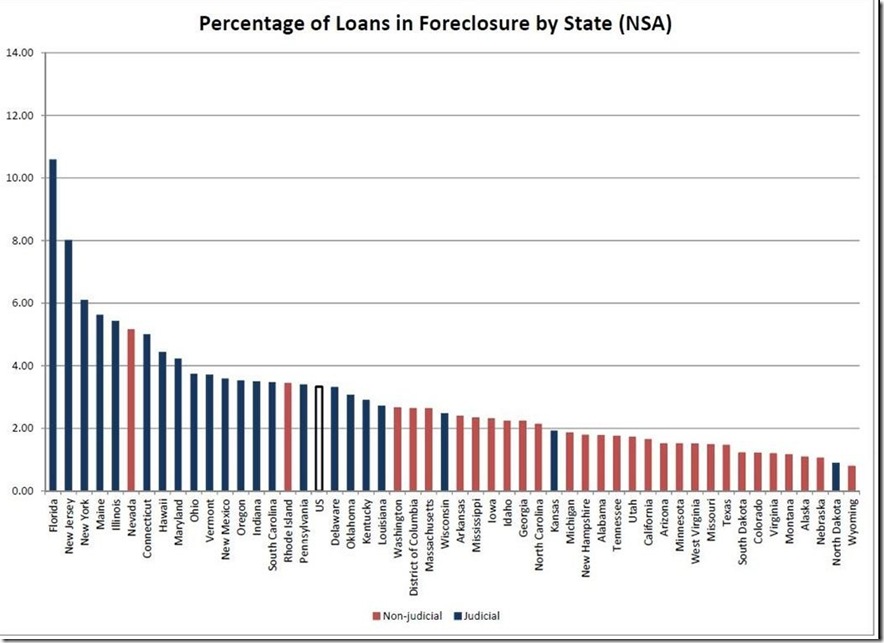
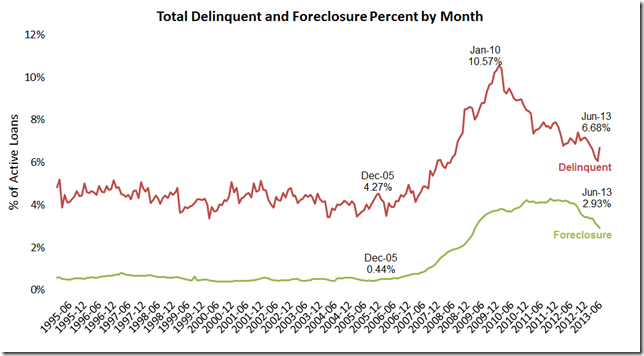
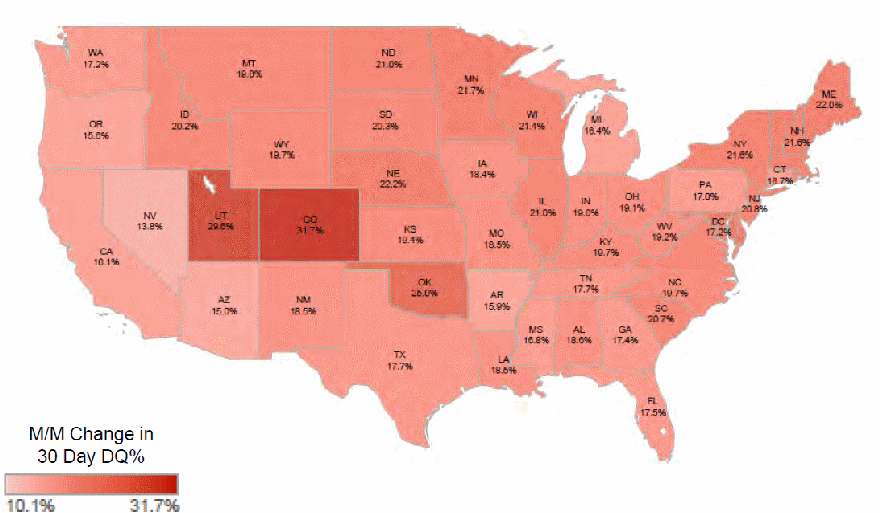
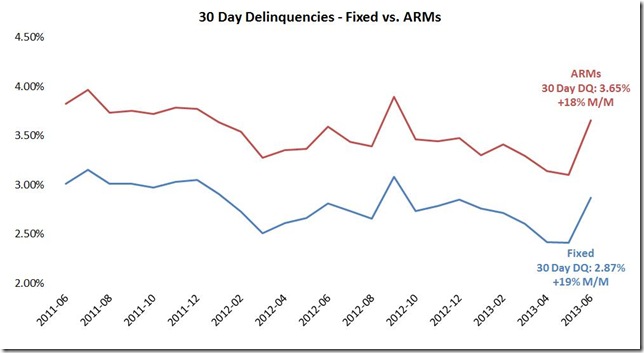
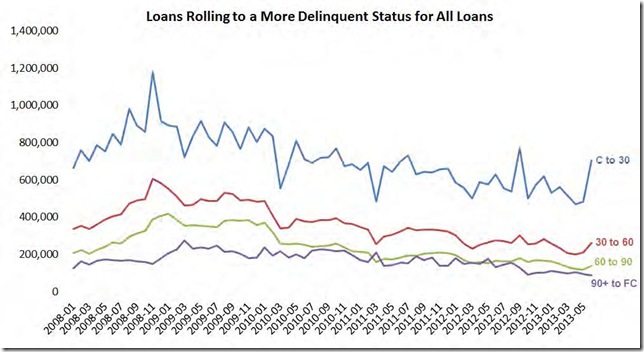
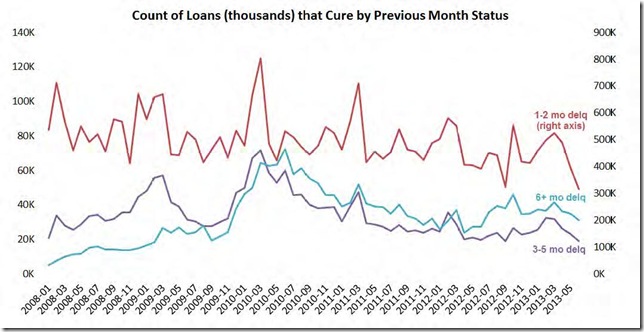
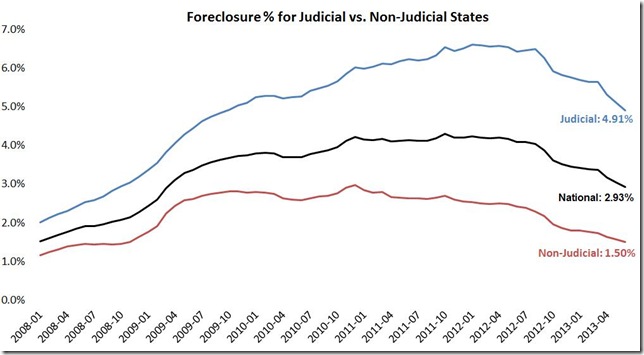
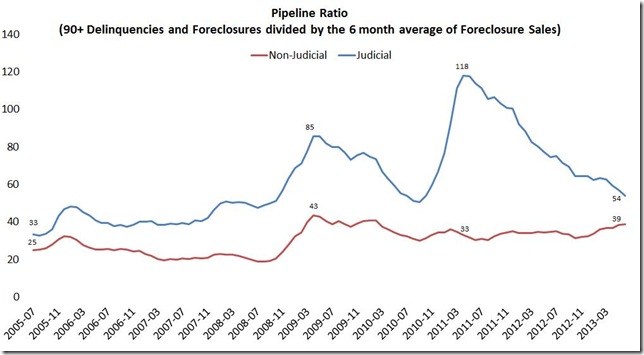
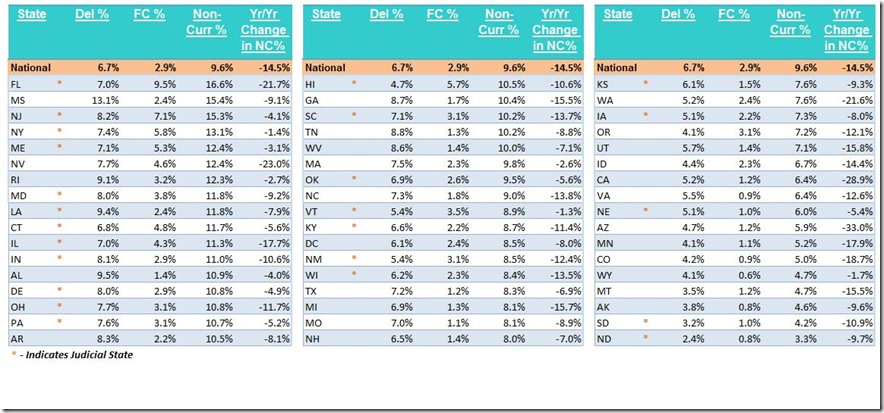
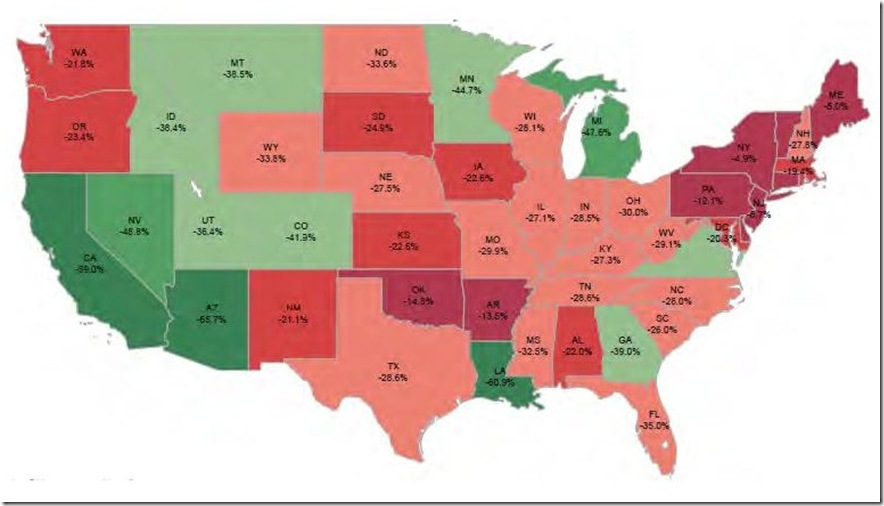



Yves,
is it possible to provide an update on Michael olenick….
he seems to have dropped from the blogosphere…
the question of how many foreclosures have taken place came up in an email exchange with robert oak of the economic populist…(who notes the Corelogic sample size is way too small)
a fair approximation can be made with the data from the LPS…here’s a capture of the loan count data from page 28 of the pdf; monthly foreclosure starts are here:
those represent the first legal action; not all are completed (ie, maybe the father in law steps in & pays it off)….but if you added the monthly totals (you’d have to extrapolate the early crisis years) and subtracted the current foreclosure inventory, you’d have something close to the total…
a rough approximation: 250 K foreclosure starts a month for 4 years = 12 milllion; another 200K a month for a year is another 2.4 million…so we have something on the order of 14.4 million foreclosure starts, minus the 1.5 million who are still in the process (notice the national average number of days that a foreclosed property has remained in the foreclosure process is now up to 860 days as of this report) leaves 12.9 million who had foreclosures started and exited the process either through a forclosure sale or by paying the overdue mortgage off…